This site contains affiliate links. As an Amazon Associate, I earn a commission from qualifying purchases at no extra cost to you. Full Disclosure Here.
Most everyone uses laundry detergent and if we’ve kept a record of the cost, at the end of the year we would be surprised at the expense for that one product alone. If we are counting our pennies, and who isn’t, it might be economical to learn more about homemade household cleaning products, specifically laundry detergent. It can be made for pennies on the dollar compared to the popular commercial brands.
The great thing is that homemade cleaning products work as well or better than the more costly products purchased from the store.
Another benefit is that our homemade versions do not have added fillers which often cause breakdown in the fiber of our clothing or cause fading and chemical residue. Here is some information to consider.
Laundry Detergent Fillers
Fillers are usually chemicals that have been added to laundry detergent to be used as a binding agent for water and to add bulk to the bottle or box of detergent, therefore making you think you are getting a better deal at the grocery store. Filler’s can count for up to 45% of your laundry detergent! Bigger is not always better!
Those fillers are there to make it appear that you are getting more for your money. It is one way for manufacturers to charge more, while you, the consumer, are getting an inferior product.
Some detergent brands may be increasing your family’s risk of asthma, skin irritation, hormone disruption, and cancer. It’s important to remember that your exposure to the toxins in your laundry soap don’t stop when the clothing is folded and put away. Some of these products are engineered to remain on and in your washed items – this is evidenced by the “fresh scent that lasts and lasts”.
I saw an ad recently that claimed that the fresh scent would last for many weeks. This is particularly true of the added wax-like scented beads which are put into the wash cycle. I know, they do smell good but instead of using those chemical filled, expensive products, I have found that adding a few drops of a favorite essential oil to a woolen drier ball works very well and smells great, with no added negative side-effects; it just doesn’t last as long.
So in addition, I often add a few drops of an essential oil to a few small pieces of felt then put them in the dresser drawer. Lavender, rose, jasmine and lemon are all nice but you can choose from the many options available in the essential oil world. There are many brand and scent options.
A few common fillers in your detergent are:
- 1,4 DIOXANE- a synthetic oil-based carcinogen
- GLUTEN- wheat and other grains are used to thicken and extend products
- ALCOHOL- decreases the detergents freezing point and increases solubility
- LIMESTONE & CHALK- Calcium based to work with phosphates in increase suds
- PERFUME & COLOR- Covers the smell of chemicals and makes it look “pretty”
- SODIUM SULFATE
Facts about Fillers
- Fillers are often made of sodium sulfate. To discover if your laundry powder contains sodium sulfate you can do a simple test. Put one teaspoon of laundry powder into a cup of water and stir. Sodium sulfate will not dissolve and can be clearly seen at the bottom of the glass. Some fillers are ground down into a very fine sand-like consistency, making them more difficult or impossible to detect.
- They get into the fibers of your clothes and grind together (with washing ) therefore they lessen the life of your clothes and make them look faded and pilled.
- After just 10 washes, clothes, towels and blankets gain 2% of their weight in detergent residue (fillers and chemicals) and are constantly being absorbed by the skin.
Save big by using “clean” detergent! I did a little poking around and found that washing machine repairmen are very aware that these fillers are causing more frequent machine breakdown. Our own repairman was very open about the subject and the shortened life span of machines due to additives and fillers in detergents.
With the cost of a washer ranging between $350. to over $1000., who can afford to replace a washing machine more often than necessary? Taking better care of your machine can give you savings that then can be used to purchase some of those special preps you’ve been wanting.
One of the main reasons we switched to making DIY laundry powder was because our youngest child had sensitive skin and would sometimes develop a rash and redness where clothes touched the skin. This reaction happened even when we switched to detergents that were touted as being mild and suitable even for babies.
We found that the two “mildest” brands caused even more skin reactions and this happened even if I ran the clothes through a double rinse cycle. It took me a while at that time to find the right detergent “recipe” that worked for her sensitive skin.
Yet another negative effect is that fillers can trap bacteria in your clothes, causing smelly, sweaty clothes to quickly smell bad again soon after washing.
Here is a website that gives grades from “A” to “F” to specific detergents and other cleaning products that you may find interesting.
People often ask if this detergent can be used in High Efficiency (HE) washing machines. Yes, it can. The first time you use this Zote recipe you may question if it is effective because it makes very few suds, if any. Rest assured that if you can get over the idea that seeing suds means cleaner clothes you will see the results and be pleased.
Recipe: Zote Powdered Laundry Detergent Recipe
2 14 oz. bars of ZOTE soap. Some folks use Fels Naphtha soap but in doing that you must consider that the Zote soap bar is about 15 oz. and the Fels Naphtha is only 5 oz. per bar. So Zote is more economical to use. There is a concern with Fels Naphtha because it contains titanium dioxide which some say is bad for septic tanks and toxic to our waterways.
I have not researched this down to the chemical level but since we do have septic I have chosen not to use it. I like the smell of Zote better anyway. Some folks use Ivory soap. You choose. The next time I make laundry detergent, I am going to use Dr. Bonner’s soap bars. They are a bit more costly but without any colorings.
1 box 20 Mule Team Borax. Borax is a naturally occurring mineral that is great for whitening and deodorizing. One of the most popular kinds of borax is made by 20 Mule Team and usually comes in 76 oz. boxes. (Wal-Mart and larger grocery markets)
Let me share some information about an ongoing confusion as to what 20 Mule Team Borax is made of and if it is safe to use as a laundry product. Borax is sodium tetraborate or sodium borate. It is not boric acid (hydrogen borate), which seems to be a misconception that’s going around the web and has caused concern about using Borax for cleaning purposes.
Borax is a salt of boric acid but it is not chemically the same as boric acid. Like many other natural substances sodium tetraborate should not be ingested nor come into contact with your eyes, nor should it be applied directly to the skin. Other than that I can find no cause for alarm and no reason to fear borax when used externally in laundry soaps or cleaning supplies.
The safety studies that I could find were related to either ingesting borax, or keeping it out of your eyes. 20 Mule Team Borax is considered pure boron, a natural element. It is considered non-toxic to humans even though it is toxic to insects.
1 box Super Washing Soda– 55 ounce size box – This is a household cleaner and laundry booster and is made by Arm & Hammer. It helps to neutralize laundry odors. This is not baking soda. It can be found near the 20 Mule Team Borax. Washing soda or soda ash; is a white powder that is used to remove dirt and odors. (Walmart and larger grocery markets)
3+ cups Baking Soda. If you have hard water this will soften it and it helps eliminate odors as well. Even though you may need only 3 cups of this larger box there are so many other household uses that using this natural cleaner, deodorizer, and personal care product, will not go to waste. I always keep at least one large box on hand. (Walmart sells the larger size box which is more cost effective than buying the smaller one pound boxes from the grocery store.)
2—16 oz. or 1– 32 oz. containers Awesome Oxygen base cleaner. Sometimes they have Awesome Oxygen Orange in a 32 oz. container, orange label and that is the better buy. They always have the 16 Oz. jar with blue label. Either is fine. (Dollar Tree) You may also use brand name Oxyclean but that can be a bit pricy. Awesome Oxygen from the Dollar Tree does the same job and is less costly
Instructions:
Finely grate the Zote soap bars. Hand grate on smallest size grate to help it dry more quickly. Spread out on cookie sheets and allow to dry for 2 days.
This step takes a little patience. It’s a good idea to wear a mask while grating the soap because it has a strong scent.
(Drying makes blending with other ingredients easier. After drying put the grated soap into a food processor in small batches, wearing a mask.)
In a very large pot or 3 gallon container begin layering all of the ingredients. Again wear a mask as the fumes and dust can be strong. When all is mixed thoroughly put into a lidded container, either plastic or glass. Use a 2 Tbsp. scoop that comes in the AWESOME Oxygen container as your measuring scoop. If you are washing a small washer-load of clothes use only one tablespoon.
You may add a scent like Unstoppables but it is not a softener and adds expense and chemicals to the detergent. I would not use Unstoppables or any added scents if this laundry detergent is to be used on clothes for babies or young children or with people who have skin allergies. As with any new product you try, be alert to any sensitivity your family might have when changing to new products.
We have not had any problems and have been using Zote based laundry detergent for about six years, but we don’t add the various chemical scents. Usually I add a few drops of natural essential oils like lavender, lemon or sandalwood to woolen dryer balls. In addition to making the laundry smell wonderful, the laundry room smells heavenly as well.
To further reduce the cost of laundry you can use crumpled up balls of aluminum foil in place of chemical laden drier sheets. These can be used over again several times. I’m always glad for more savings.
If you try this laundry detergent recipe and want to store enough of the individual ingredients for the next year’s batch, I have a few suggestions, gleaned from sad experience. Any powdered product stored in cardboard can absorb moisture fairly quickly causing the contents to clump and even turn into a solid mass, especially if the box has begun to split a bit at the seam….(see photo below)
I know I could probably hit this Washing Soda clump with a hammer and put them into the food processor or blender but it’s so hard packed that I’m not sure this would be a wise thing to do. Using a serrated spatula to scrape the block into a large container seems to work, but it isn’t something I want to repeat any time soon, even if my dear husband is willing to help. Hopefully this will be the first and last time this challenge arises!
As soon as the boxes of Borax and Washing Soda are purchased I will put them into larger canning jars with lids along with a clay desiccant packet or oxypacks. Another way to keep the powders away from moisture would be to seal the inner part of a two piece canning lid using a Food Saver Jar Sealer. That process takes about 10 seconds.
Another option would be to place the unopened box into a plastic bag to protect from moisture. This only needs to happen if you are storing these ingredients over the period of 6 months to a year. Just give them a check now and then.
LA’s Totally Awesome Oxygen. This stuff is also great for spot cleaning carpets. It does a good job on grout and tile after making a thick paste, applying it to area and allowing it to stay there for about 5 to 10 minutes before washing it off with a wet cloth.
Put the dried, grated soap into the food processor in batches. If you opt not to do the drying process you take the chance of ending up with a sticky substance that will not blend well with the other dry ingredients, so take the time to air dry the grated soap bars to assure an even blending of all ingredients.
The Zote soap that has been grated, dried, and then run through the food processor condenses down to about 4 cups of concentrated powder. This is two large bars. Surprisingly this pure soap “powder” melts in cold, medium and hot water with just a little agitation. Remember there are little, if any, suds. Don’t let that fool you. This is a powerful cleaner.
Next, collect all ingredients and put on a surgical type mask. Into a large container, like this 3 gallon bucket, pour all five powders and blend well and evenly.
 |
 |
 |
 |
Using a sturdy spoon blend all ingredients until evenly dispersed. If you don’t use a mask the concentrated dust from the grated soap and the Borax dust that billows into the air will get into your lungs, so don’t take the mask lightly.
Final Thoughts
Finished product: About a year’s worth of laundry detergent for $12.50! We are now a family of two so you can extrapolate your own family’s approximate needs based on that calculation. This will do approximately 225 loads of laundry using 2 tablespoons per load.
For extra-large or heavily soiled laundry you could use up to four tablespoons. The plastic scoop that comes in the LA Awesome Oxygen cleaner container is exactly two tablespoons.
There are no fillers or harmful substances in this detergent so a little goes a long way. Of course, there are still sensitivities to detergents so be alert when you begin using a new product. Avoid getting into your eyes or having direct contact to your skin in concentrated form.
One question that might be on your mind is, ”Can I make liquid laundry detergent?” You sure can. The reasons I choose to make the powdered soap are simple. First, to make the same amount (enough to wash 225 loads of laundry) and using this very exact recipe, if converted into a liquid form it would equal 10 gallons! That would take up a lot of my laundry room space.
Second, the liquid version settles and clumps a little so must be shaken up or stirred if left sitting for long.
Third, what containers should you use to store the liquid version in? One might think that clean plastic gallon milk jugs would do the job. There are two drawbacks with this choice. The milk sugars cannot be completely cleansed from the plastic, so there is a possibility of contamination. The other reason is that the plastic jugs are likely to breakdown and disintegrate.
I don’t want 10 gallons of liquid laundry detergent oozing all over the floor! (This breakdown of milk bottles happened to a friend and she was only storing water!) If you have high mil, clean plastic containers in mind and you have the space then go for it and store 10 gallons.
You can choose to use two five gallon heavy plastic buckets. They are difficult to move when full and still must be stirred every once in a while, so you’ll need a long stirring stick or agitator. I have a friend who chose this route last year and she’s quite happy in her choice.
What I have given you in this post is one recipe and one way to cut laundry costs that I have found effective and, of course, economical. There are variations and substitutions which can be used. I’d love to hear the experiences and tweaks you may have used for your laundry needs. If you have not tried to make your own laundry soap I hope you’ll put this one to the test.
Blessings, Donna
If you enjoyed this article, consider following our Facebook page.


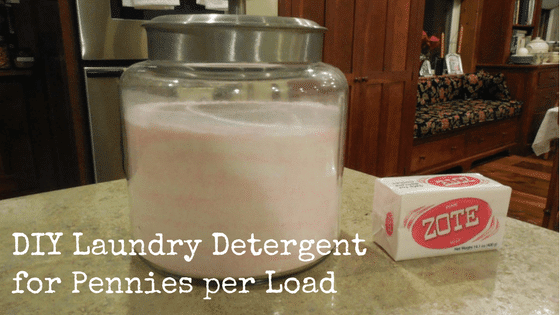

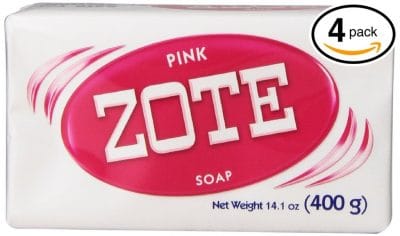



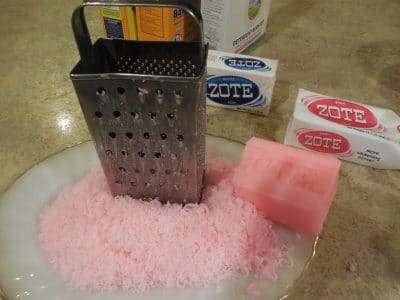

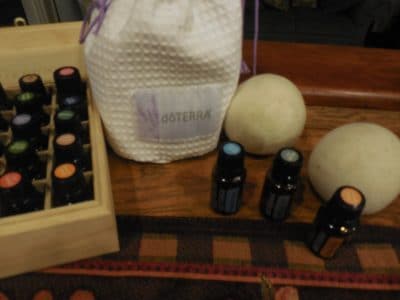

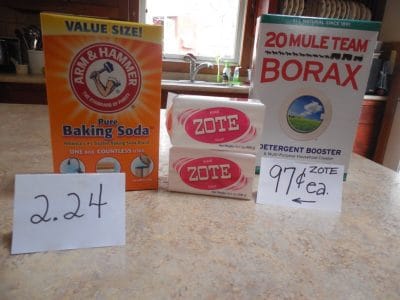
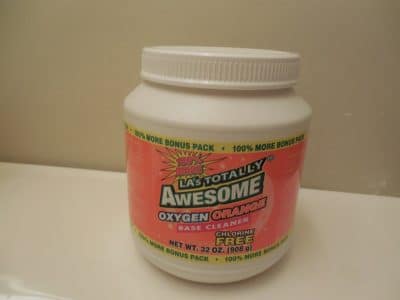

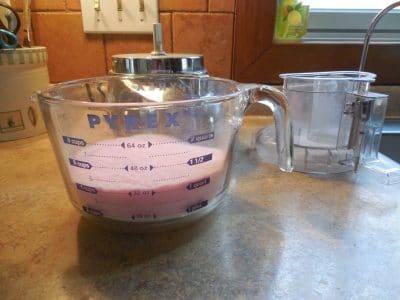
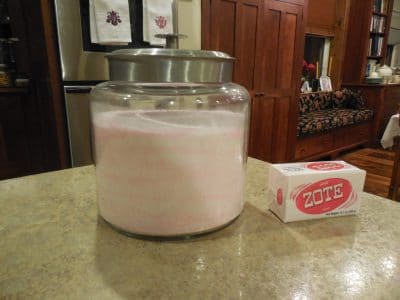
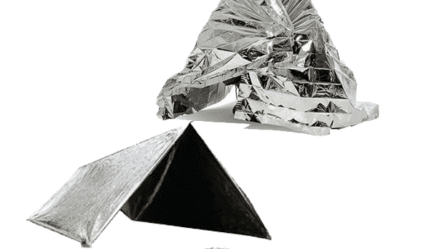






117 Responses to “DIY Laundry Detergent for Pennies per Load”
I have never been happy with the grated soap version of DIY Laundry Soap. I keep trying new recipes and formulations that are sent to me by BDS readers but always to this version.
Vinegar in your laundry rinse removes soap residue from your clothes which is how it softens them. This means it has to be added to the rinse cycle somehow. So when you think your darks are “brighter” after a vinegar rinse, it’s not your imagination; it’s just there is less soap residue making your clothes look dingy.
I’ve made homemade powdered detergent with grated soap and found that the smaller the grated soap, the better. So I use a $1 store small grater. But even still there are sometimes problems due to not dissolving completely.
I used to use Dawn to clean cloth diapers so this recipe is very interesting to me. I’m going to have to try it out.
Excuse me, but if you add 8 cups of boiling water and shake, aren’t you going to have a massive geyser eruption?
Two things that perhaps were not clear. Only add 2 cups of boiling water to “shake” and dissolve the powders. In addition, do not cap the jug before shaking it up. I have never had a problem with a geyser eruption using that method.
When ever I make my own liquid laundry soap, I only use 1/2 the water the recipe calls for. . . then I only use about 1/4 cup per load. . . saves on storage space as well as being concentrated.
I also make my own *stain sticks*… Since I am a soap maker, I rebatch & use up my leftover soap trims, add a little water and melt in a crockpot. I use about 1 to 2 pounds of soap, & other ingredients, mix well and scoop out into a mold. . . I wait about an hour for it to harden up and cut into 1 x 1 x 4 inch sticks. In 2 days they are super hard and ready to use. Just wet the fabric & the bar & rub.
I make my laundry detergent using the bar soaps with good results. If I’m washing my husband’s really filthy work clothes I throw in an extra 1/4 to 1/2 cup of washing soda. I make my own “Oxi-clean” with boiling water, washing soda and hydrogen peroxide. It works well on organic stains but can bleach dark clothes. For a while I was making my own dishwasher detergent with one part borax and one part washing soda then adding vinegar to the rinse cup. I quit using it because I found it etched my glassware and flatware. The borax makes the BEST toilet cleaner. It leaves the bowl sparkling without the use of caustic bowl cleaners!
Leah, I know this is a rather late reply to your post, but still had to add my 2 cents worth!
… You can save money on your *homemade oxy-cleaner*… 2 ways to save— 1. If you use the generic Oxy-cleaner (available from Dollar tree, or the Sun brand) and add water to that, you will end up with the same product in the end. . . . The Oxy-cleaners are made up of the same ingredients, — Washing soda and peroxide… . . . 2nd way to save— Dollar Tree Also has a product called *Oxy Power*, it is a liquid, white, 1/2 gal. bottle for $1.00— I love it, works as well as name brand (Clorox brand Oxy-cleaner is about $4.00 for a 24oz spray bottle).
Angel
No one has mentioned dryer balls. They work without harsh chemicals. They are cheap and last forever. I use 3. I guess the norm is 2 since they come in pairs. I wouldn’t use anything else. No toxins (poisons) in my laundry or home. I won’t use Dawn since it is toxic. Instead I use my organic non-toxic laundry detergent in place of Dawn to make my DIY laundry detergent and Dirt Cheap hand soap. I’m going to get some Fels-Naphtha bars to try. I used coconut bars and it worked well. Using filtered water to make the DIY laundry liquid is kind of an oxymoron since the water used in our washers come from our taps. However, it’s necessary in the hand soap…love all these DIY recipes. I’m for saving money and my health.
@Vicki – Funny that you mention dryer balls. I just pulled a “recipe” for making dryer balls off of Pinterest and was planning make some up with the lavender in my yard later this summer. The dryer balls were made from old socks and dried flowers.
@Jean – Absolutely. This is very low-sudsing. And btw, my machine is an HE as well. Congrats on being the grand-mommy of twins. Very cool 🙂
Best,
Enjoyed the article – my lovely daughter-in-law is interested in learning to make her own laundry detergent because she is expecting TWINS in June (my first grandbabies) and wants to keep their costs down as well as limit chemicals in the babies’ clothes. I sent her your recipe but she asks if it will work okay in their new high-efficiency washing machine? Have you or any of your readers given it a try?
Thanks for all the good info you post!
hi Gaye, great article on DIY laundry detergent. something you might try as an additional ingredient when you have really greasy, nasty clothes to clean up is tri-sodium phosphate. this is what used to be in all laundry detergents until the government in all it’s wisdom made the manufacturers take it out. you can find it in the paint section of Home Depot with a big TSP on the box. i haven’t actually mixed it up with your recipe but when i’m cleaning up kitchen cabinets coated with grease or tobacco smoke or both there is nothing that works as well. you don’t need much and i’ve found nothing that cuts grease and dirt quite as well. always enjoy your blog, james
Very cool. I will pick some up and give it a try. Someone had mentioned using Sun products from the Dollar Tree but when I was there yesterday, I just could not wrap my mind around the stuff. Have a wonderful holiday! . . . Gaye
Although it does work well, TSP has phosphates, which are environmentally hazardous.
I have been using the Fels-Naphtha, Borax and washing soda laundry soap for almost 2 years now. After finding this ‘recipe’ last week, I gave it a try. Not only can I make a 1/2 gallon of this in minutes, my jeans also seemed much softer coming out of the dryer.
I still have to do the math on cost, since I believe the Fels-Naphtha version cost me around 22 cents a gallon. With your recipe, I used Walmart’s brand of “Dawn”, which BTW, was also ultra concentrated. I imagine if I used the regular dish soap, I could save even more.
Thanks for this, Gaye!
I believe I mentioned that I have been using this DIY laundry detergent in cold water only for additional savings. I am working on some other DIY cleaners so be sure to check back.
Also, I have some Costco/Kirkland brand dish soap that I set aside because I do not care for it but since it is so much cheaper than Dawn – and I already have some – I want to see how it works in this laundry recipe. Stay tuned 🙂
Re Stain removal:
I use regular 3% Hydrogen Peroxide from the drug store. Apply to stain, let dry. Keep doing this until the stain is gone, then put in laundry. It even works with turmeric, though takes 10 or more applications.
Hope this helps.
Something else for me to try 🙂
Hydrogen peroxide is a miracle remover for blood stains. As a nurse, I’ve used it a good bit. May take several applications, but it will usually bubble it away. Take care not to let it soak in your clothing too long, however. I rescued an injured chicken in my favorite white cotton blend shirt. It was badly stained, so I left in in the peroxide overnight. Had holes in it the next day! >:(
Also, I’ve found that using straight Dawn with a toothbrush on stains, especially “ring around the collar” really works well!
Thanks for the recipe and all the hints, y’all!!